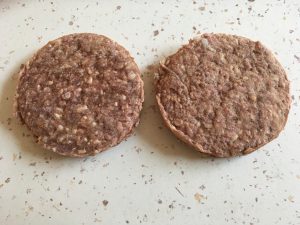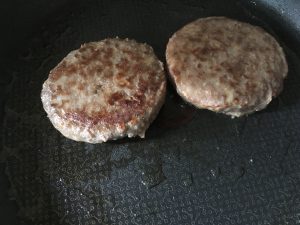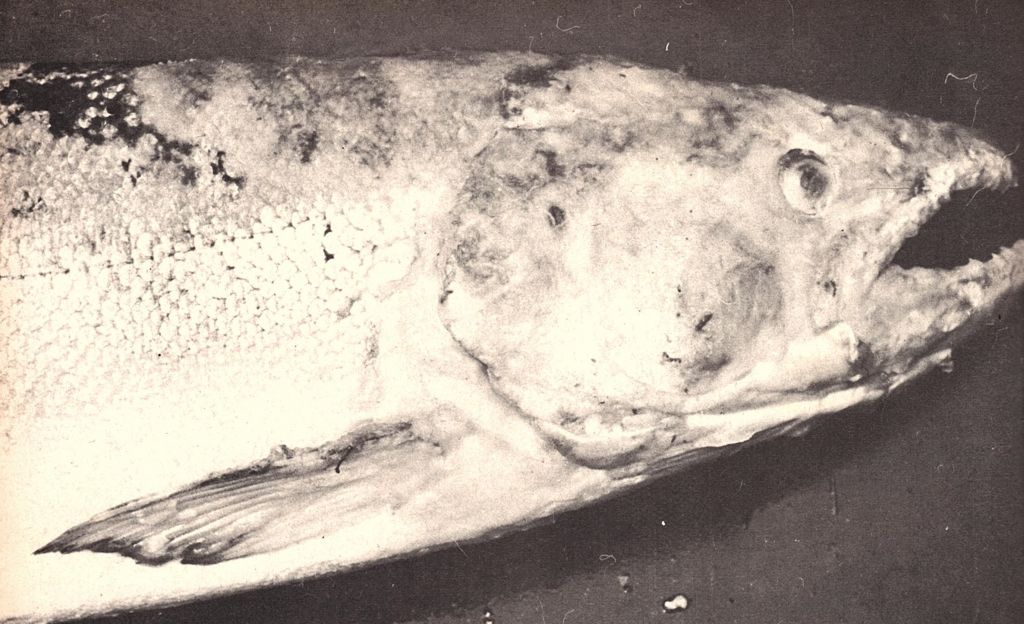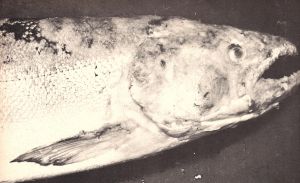No other explanation?: Salmon & Trout Conservation (formerly the Salmon & Trout Association) have issued yet another press release. We assume that the timing was intended to persuade the Scottish Parliament’s REC Committee that their forthcoming report should come down heavily on the salmon farming industry. The S&TC’s latest attempt to influence the Committee reveals that an important Hebridean wild salmon run has been decimated by parasites. They say the fish returning to the River Blackwater must pass through Loch Roag where they have picked up hundreds of lice from nearby farms and this infestation led to the discovery of ‘many dead, dying or distressed adult wild salmon. These fish were found in the tidal section of the lower part of the river’. S&TC say that the fish were smothered with many hundreds of sea lice, which have eaten away the skin of the fish and they have ‘extensive and graphic photographic and video evidence showing the extent of the infestations.
Andrew Graham Stewart of S&TC says that laboratory tests have failed to find any other possibility than the fish being killed by the lice. Guy Linley Adams of S&TC revealed that the Fish Health Inspectorate have been to the Loch Roag farms, but he said that the law means that they are only able to involve themselves in the health and welfare of the farmed fish.
When we read the press release on Monday 3rd September on the S&TC website, a number of key questions sprung to mind:
- Sea lice
Salmon & Trout Conservation say that many dead, dying or distressed fish were found in a tidal section of the lower river. They suggest that a substantial proportion of the river stock has been killed by a plague of parasitic sea lice.
We, at Callander McDowell, have been looking at the impacts of sea lice on wild fish for the last eight years and we have not heard of a single incident where numerous fish have died in a single incident due to sea lice infestation. Back in 1987, sea lice were blamed on the collapse of sea trout stocks on the west coast of Ireland. Yet after a prolonged investigation, it emerged that the problem was that the fish were actually starving due to a lack of food due to abnormal sea conditions. The weakened fish became stressed and subsequently succumbed to a secondary infection of sea lice.
The occurrence of starving sea trout does not appear to have been repeated because the local conditions at the time were both unusual and unique. Declining catches of wild fish have been attributed to the presence of sea lice but there is no hard evidence to prove that this is nothing more than coincidental.
- Fish deaths
S&TC imply that these deaths occurred either together or over a very short period of time. When the press statement was first released by S&TC on the 3rd of September, we tried to find out more about the incident but with only limited success. These deaths have subsequently been described to us a ‘fish kill’. We have already mentioned the fish kill in Ireland that was due to the introduction of a chemical resulting in a large number of deaths over a short period of time. It seems that this ‘fish kill’ in the Blackwater River also occurred relatively quickly, with fish either dead or near death when they were discovered.
The question is what could have caused such a rapid response. Although we will be a lone voice in an ocean of criticism at the industry, we certainly don’t believe the deaths were the result of sea lice. Instead, we would argue that the likely cause of death was the abnormally high temperatures, experienced across Scotland. BBC News reported this week on their website that Scotland’s rivers are basking in record temperatures. Scientists at the James Hutton Institute found that the River Gairn hit a record high 27.5oC and have warned of potential impacts on river ecology. The BBC say that the high temperatures are a real threat to wild fish. They certainly lead to lower oxygen levels in the water and this can be disastrous for fish like salmon. Interestingly, this would not be the first time that we have heard about low oxygen conditions in the Blackwater River.
Back in 2012, the Herald newspaper reported that the Garynahine Estate on the Blackwater had landed the most fish since the 1880s with a total of 555 fish. This was at a time when the five-year average was just 116 fish. The newspaper reported there had been an inauspicious start to the season as a two-month drought had led to fish being trapped in pools near the river mouth. The river’s ghillie, Donnie Whiteford, had expressed concern that there was too little oxygen in the water but changing conditions just before the fish started to really suffer meant that fishing could begin. We seem to remember that some angling commentators had suggested that the record number of fish caught was down to the fact that they were trapped in the lower part of the river and it was a case of easy pickings. One angler posted a comment on the salmon fishing forum on the 23rd July 2012, 21 salmon and 12 sea trout today. That’s some sport…. Another angler posted the following day that there was rain all day which had put some freshwater into the sea pool where a lot of fish were stuck but they were likely to be still there as the river had been bone dry.
Undoubtedly, this year must have seen a repeat of the low water conditions in the river due to the exceptional summer weather. Inevitably, as in 2012, the fish became trapped in sections of the lower river. We suspect that if fish did die in large numbers at about the same time, a more likely reason would be poor water quality including low oxygen levels. The fish will have become extremely stressed and subsequently suffered a secondary infection of lice that reproduced on the fish whilst they were stuck in in the saline, but also warmer water of the sea pool.
Since we wrote these comments, further information has become available. The Ferret has published the contents of a letter from the proprietor of the Garynahine Estate to the REC Committee and Marine Scotland. This letter also includes a day by day account of what happened in Blackwater River. This detailed account of events does nothing to change our view of why these fish died.
The first entries of this diarised account are most interesting:
11 June – Sea trout and finnock were seen going in and out of the sea pool with tides that week.
15 June – First salmon and grilse arrived in sea pool/ Heavy sea lice burdens, but no counts done and not sufficient lice to cause concern. Low water at this time and fish stayed in the pool.
From 15 June through to 19 July – Numbers of fish in the sea pool increased but there was no freshwater to allow fish to run upriver. Approx half of the tides during this period would enter the sea pool and the water was saline the entire time.
By 18-19 July – The fish were showing signs of stress – constantly flashing on their sides underwater cruising very slowly and remaining static near the surface with tails and fins showing generally very lethargic. Fishing was suspended on 19 July and a few dead fish were found on the banks having beached themselves.
Week commencing 23 July – The proprietor then relates how he started to collect dead fish and subsequent attempts to net the remaining fish so they could be transferred them to deeper water. He also talks about visits from the local Fishery Trust and the Fish Health Inspectorate.
He ends his account by saying that nobody has been able to offer any explanation for the high numbers of sea lice on the Garynahine fish other than they came from the farm.
Perhaps his view is indicative of an industry that is more interested in catching and killing wild fish for sport than knowing and understanding about their welfare. His account raises a number of questions.
He said that on June 15th, he observed fish carrying a heavy burden of sea lice arriving in the sea pool. Whilst he made no attempt to count the lice, he said he was not concerned. Surely, a heavy lice burden must be of concern but clearly it wasn’t sufficiently heavy to put a stop to the fishing. This wasn’t suspended for at least another four to five weeks. Fishing was only stopped when fish were showing clear signs of stress.
Fish were observed coming into the Blackwater system carrying sea lice. This is entirely natural and would be expected. Many anglers relish catching a sea liced fish. The problem is that the fish were entering a shallow sea pool which had no access to the river. It is common knowledge that this summer has been one of the hottest on record and high temperatures extended even to the Hebrides. On July 13th, the Times newspaper reported that the heatwave was threatening to plunge the whole of Scotland’s angling industry into crisis. David Summers of the Tay District Salmon Fishery Board told the paper that there were fears that hundreds of fish could die in the River Tay, unless significant rainfall was forthcoming. There were similar concerns on the Tweed where fishing had all but stopped. At a time when salmon numbers are already low, the heatwave was described as being disastrous for everyone connected to salmon fishing.
In common with these big east coast rivers, the water temperature in the Blackwater’s shallow sea pool will have been rising throughout June and July. As the temperature increased, the fish would have become increasingly stressed. Sea lice also respond to warmer temperature with a shortened lifecycle. The lice would have proliferated quite quickly, taking advantage of the stressed and increasingly weakened status of the fish. With no fresh water coming into the sea pool, the outcome was unfortunately a forgone conclusion. Remedial action to remove the fish out to deeper waters was probably carried out far too late.
Stress is not something that can be measured in dead fish but given the circumstances, the most likely cause of death was stress exacerbated by a secondary infection of lice. It has been suggested that the farm was the main source of the lice but actually, the fish were probably carrying a natural population of lice long before they entered the sea pool.
We have been sent details of a blog from someone called the Lewis Chessman. He details the rescue operation that began on July 30th, over a week after fish started to die. One sentence of his account attracted our attention. He writes “A prolonged drought had prevented access to the river for several weeks causing the wild fish to cruise up and down the sea loch, Loch Roag, following every tide past numerous farmed salmon cages day after day”. We presume that this is the local explanation as to how these fish became to carry a large number of lice, but we have some difficulty with the time line. If these fish had been cruising up and down Loch Roag for several weeks, then they must have been heading for the river through the loch sometime in April. However, the Garynahine Estate website states that ‘Salmon and Grilse normally enter the system towards the end of June and fishing continues until mid-October’. The proprietor’s account says that salmon started to appear on June 11th which fits in with their usual return. The problem is that having entered into the lower reaches of the river, they were unable to go no further and became trapped.
Lewis Chessman recorded the rescue of the remaining fish and his photos can be seen at: https://www.flickr.com/photos/jamesbarlow/sets/72157699313759404
What is most apparent is the shallowness of the water. We would expect the water to become extremely warm in these shallows and therefore it is not unexpected that stress would lead to the inevitable deaths of these fish.
Of course, images of sea liced fish prior to death are a godsend for S&TC as it gives them another excuse to continue their attack on the salmon industry. However, before the salmon farming industry is made the scapegoat yet again for the wild fish sector, and before the REC Committee jump to conclusions, there should be a full and proper consideration of the matter rather than the current trial by media.
- Investigation
Contrary to the suggestion made by Guy Linley Adams, we understand that the Fish Health Inspectorate did visit the site and did take samples. At the same time Andrew Graham Stewart says that laboratory tests failed to offer any other possibility, but he does not say which laboratory undertook these tests however according to his colleagues, it couldn’t have been the Fish Health Inspectorate.
In the early 1980s, the cause of the deaths of sea trout in Ireland was initially attributed to sea lice because they were the most obvious indication on the fish. Mr Graham Stewart is so focused on the sea lice issue that he is unlikely to see past the presence of the lice on these fish.
- Photo and video evidence
The S&TC offers one single image of a fish infested with sea lice together with a short video of what appears to be the same fish. They say that they have extensive photographic and video evidence but our request to see this evidence has been met by silence. At least the Lewis Chessman’s photos give more of a realistic coverage of the deaths.
Salmon and sea trout do get infected by lice and when fish are sick or damaged, these infestations can become widespread on an individual fish. However, images of one fish with advanced sea lice infestation does not mean that the whole wild fish population are suffering in the same way. As we have pointed out in previous issues of reLAKSation, sea lice infestations in the natural population usually affect a few fish but these fish tend to be carrying large numbers of the parasites.
It seems that the S&TC video has now prompted other anti-salmon activists to post their own attempts to persuade politicians about the problems of salmon farming. However, what they fail to appreciate is that a video of a few fish covered in lice are not necessarily symptoms of a wider problem. As in the wild, some farmed salmon will always be weaker fish. Other forms of agriculture have poor-doers too.
Amongst all the media coverage highlighting ‘Shocking video’ Fishupdate tells it like it is with a headline – ‘Activist breaks into Scottish salmon Farm’. The coverage begins ‘A Scottish salmon famer has been targeted by an activist who broke into a farm site without permission to take underwater photographs.’ If someone sticks a video camera below the surface of a salmon pen, inevitably there will be a few of these weaker fish hanging in the upper water column. It is not always easy to remove these fish without disturbing and potentially stressing the main stock. As in the wild, the weaker fish will succumb to secondary sea lice infection. Of course, they don’t look nice, but they are not necessarily representative of all the fish in the pen. The video footage from the farm was dated 27th August, some weeks after fish were transferred out of the Blackwater. Could it be that lice from these fish spread to the farm?
The trouble is that the anti-salmon farming lobby see one photo and cry foul. Of course, because the raised profile of salmon farming means it gets the blame for anything that happens to wild fish, there is a tendency to forget that wild fish succumbed to disease long before the advent of salmon farming.
We recently came across the following black and white photos of diseased salmon from the 1960’s. They come from Trout and Salmon magazine, which featured what became known as the salmon disease in many issues over several months. When the disease is correlated against rod catches at the time, it is possible to see that the disease had a major impact on the wild fish sector. No-one talks about this anymore because should any wild fish die, the salmon farming industry always gets the blame.
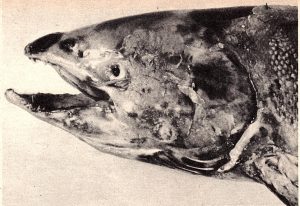
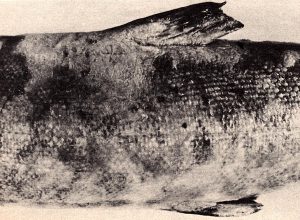
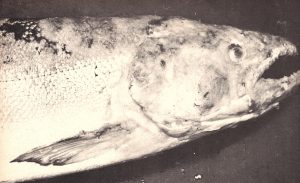
- Publicity
According to S&TC, these fish deaths occurred towards the end of July. That was at least five weeks ago, yet it seems that their press release is the first public news of the incident. We would have thought that large scale fish deaths attributed to the presence of salmon farms would be big news but despite a trawl of the most obvious sources, we were unable to find a single reference to these deaths before the 3rd of September. Andrew Graham Stewart writes for the leading salmon angling magazine, Trout & Salmon but even this publication has not included reference to these deaths either in the main body of the magazine or the fishing reports. The magazine is published monthly with an additional autumn edition and yet nothing has appeared so far. The latest (Autumn) issue of the magazine does however report a major fish kill in the Ollatrim River in Co Tipperary in Ireland that led to the deaths of 14,749 fish including 70 salmon and 1,400 sea trout that also occurred in July. The deaths are blamed on the release of a pesticide or herbicide. Co Tipperary is a land-locked county with no access to the sea or salmon farms. Given the amount of publicity that has followed the S&TC announcement, it seems incredible that the news of the fish deaths was not announced at the time. Clearly, the wider issue for the S&TC is more important than the actual sorry event.
The problem with Salmon & Trout Conservation is that they appear to blame the decline on wild fish on a single issue when it is perfectly clear from across Scotland that there are many issues to consider.
Global collaboration: The Global Salmon Initiative is five years old. The mark of this initiative is pre-competitive collaboration that allows companies to come together to discuss and address issues that affect them all. They have tweeted that ‘Over the last five years, we have learned a lot about pre-competitive collaboration as a way of accelerating environmental improvements. They say to read their poster to know the ‘secrets’ of their success.

We, at Callander McDowell, have never been great fans of this venture. We are not against the idea that salmon farming companies should come together but it is the manner of doing so. It is only necessary to read this poster to understand our concern. No-where in this poster is the word ‘salmon’ mentioned. This is because those who have organised the GSI and who stay in the background are more interested in developing the model of pre-competitive collaboration than developing the salmon industry. This is the WWF. They want to extend this model across all of agriculture and are using the salmon industry as their guinea pig.
As we have regularly pointed out, the WWF is using its muscle to mould the salmon farming industry into its own vision of aquaculture. This is a vision which we certainly have not signed up to. We suspect that salmon farming companies believe that it is better to work with the likes of the WWF than fight against them, but the vision has to be the right one.
GSI claim that the last five years have been a great success, but for us, the underlying issues remain. It is only necessary to read the latest company reports and see that sea lice are still a major issue. Clearly, all the talking within GSI has still failed to resolve this vexed issue.
This does not mean that salmon farming companies should stop talking to each other, we just don’t think that they need GSI overseeing them.
Surf and Turf: Some time ago we discussed the possibility of introducing fish and seafood to younger consumers who rarely eat it through the idea of a surf and turf burger. This would consist of two patties, one of meat and one of fish or prawn. Now we have come across an enterprising retailer who have put the two together in one burger.
The UK frozen food retailer Iceland have launched a surf and turf burger consisting of a quarter pounder with the addition of Norwegian lobster (16%). We, of course, had to taste this new offering.

The patty looks like any other meat patty but we are still not sure of the taste. It definitely has a different taste, but we had difficulty in saying what it was. It wasn’t fishy. It was just different. We suspect that once the patty had been made into a burger such as illustrated on the pack, any difference would be hard to detect. It’s a nice idea but one that may need some more work.
